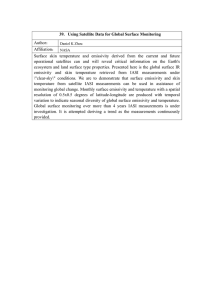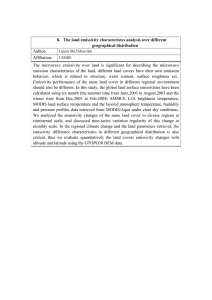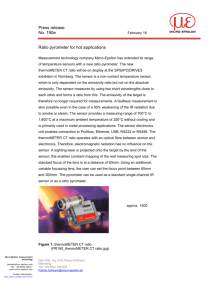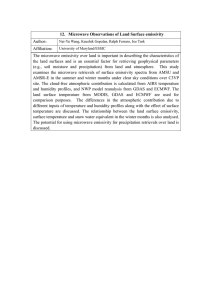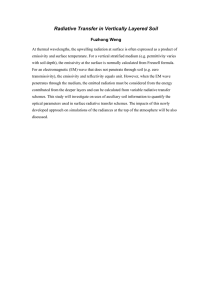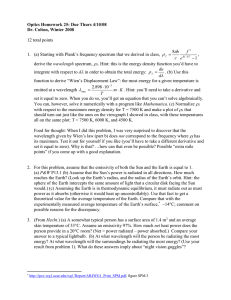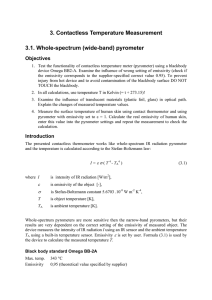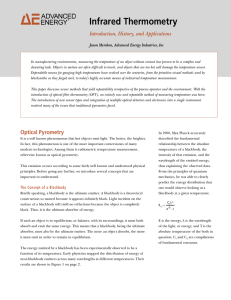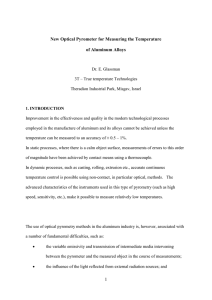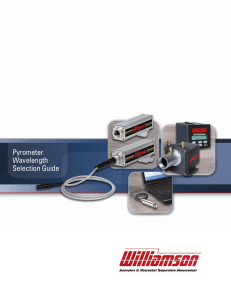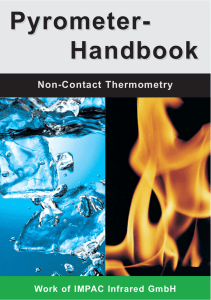Ch 2 - Pyrometer
advertisement
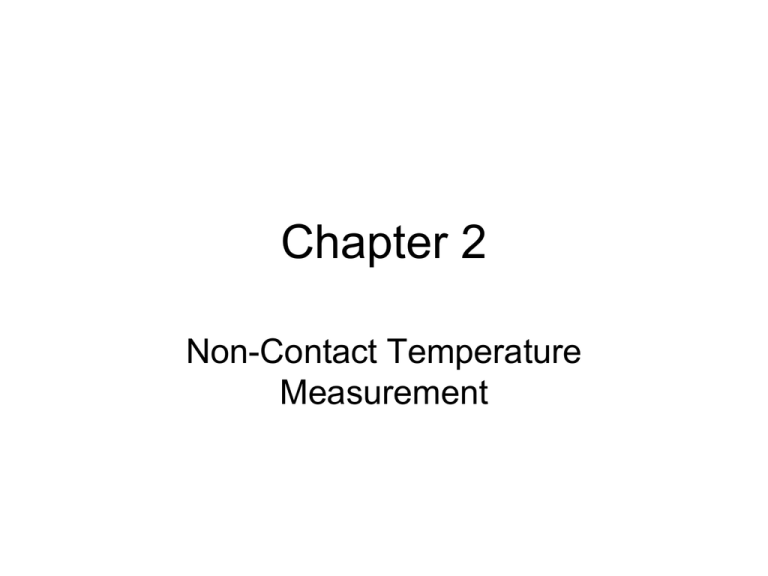
Chapter 2 Non-Contact Temperature Measurement • Pyrometer – any non-contacting device that intercepts and measures thermal radiation. • Pyro is Greek for Fire • Meter is Greek for Measure • Thus Pyrometer measures fire. – (actually temperature!) • Pyrometer – works on basis of Stephan-Boltzman Law • E = ε ρ T4 E = object’s radiant incidance (W / m2) ε = emissivity of object (no units 0 < ε < 1) ρ = Stephan-Boltzman Constant 5.672 x 10-12 W/(cm2 deg4) T = temperature in Kelvin • We assume objects temperature is directly proportional to the radiant incidence of the object. • Thermocouples and Resistance Temperature Detectors (RTDs) need direct contact. Pyrometers don’t. • Emissivity is amount of energy emitted by object. Blackbody has ε = 1. • http://www.brannan.co.uk/thermometers/invention.html • The coldest that water can get without freezing is when it contains its maximum salt content. Salt water can get as low as 0 degrees Fahrenheit. • Putting salt on roads won’t work below 0 degrees Fahrenheit. • Thermometers were marked at 12 degree increments. • 96 is divisible by 12 Measuring Temperature • Thermometer – Typically based on thermal expansion • Bimetallic Strip • Liquid in glass • 2 reference points – Ice point (freezing point) – Steam point (Boiling point at 1 atm pressure.) Temperature Scales • Fahrenheit – Ice point = 32OF – Steam point = 212OF – Divide into 180 equal steps 212o 100o 180 steps 100 steps 32o 0o • Celsius – Ice point = – Steam point = 100OC – Divide into 100 equal steps 0OC Temperature Scales • Kelvin – Based on concept of ‘absolute zero.’ – Coldest temperature possible = -273OC – 0K = -273OC • Note it is NOT OK! • Rankin – 0R = -460OF • Coldest temp possible • measured in Fahrenheit. Conversions • Between OC and K – TK = TC + 273 – TC = TK - 273 • Between OC and OF – Must correct for step size and starting point – TF = (9/5)TC + 32 – TC = (5/9)(TF - 32) Example • Convert 70oF to Celcius. – TC = (5/9)(70 - 32) = 21oC • Convert 21oC to Fahrenheit – TF = (9/5)21 + 32 = 70oF • Convert 21oC to Kelvin – TK = 21 + 273 = 294 K • Convert 294 K to Celcius – TC = 294 – 273 = 21oC • E = ε ρ T4 E = object’s radiant incidance (W / m2) ε = emissivity of object (no units 0 < ε < 1) ρ = Stephan-Boltzman Constant 5.672 x 10-12 W/(cm2 deg4) T = temperature in Kelvin • Emissivity and absolute temperature influence radiation (or energy or radiant incidance). • Object at 200o C has 16 times greater energy than one at 100o C, since 24 = 16 • Emissivity – measure of objects ability to emit or absorb radiant energy. • 0<ε<1 • No units • ε = 0 is perfect reflector. Surface doesn’t emit nor absorb radiant energy. Not good for IR temperature sensing. • ε = 1 is perfect blackbody. Absorbs all energy. Very good for temperature sensing. • Greybodies – not quite a blackbody, but very close. • Other factors which influence surface emissivity – Surface texture (degree of roughness or oxidation) – Surface temperature – Wavelength of emitted energy • Don’t use IR pyrometer for surfaces with low emissivity value less than 0.5. – Won’t get accurate results. • You can enhance a surface with low emissivity with the following: – Texture the surface by sanding or sandblasting – Oxidize the surface – Anodize the surface • Electrolytic process to oxidize the surface. – Paint the surface with dull, highly-absorbent coating. • Non-contact IR sensors have advantages over contact sensors – Can mount the sensor away from the heat source – Can sense the temperature of a moving object – Sensor won’t sink or draw energy from the object – Can view object through window in contaminated or dangerous environment. Nongray Bodies • False readings if emissivity < 1.0 • Set compensator depending on emissivity of object. • If emissivity of object is 0.5, set compensator to 0.5 • Errors are in series. – If object is 0.5 and measuring through glass with 0.4, then total emissivity is 0.5 * 0.4 = 0.2 – Table 2-1 on page 37 shows some emissivity values. Wavelength (microns) Ultraviolet ranges from 0.2 µm to 0.5 µm Infrared ranges from 0.7 µm to 1.0 µm Environment may attenuate signal. Wavelength (microns) Ultraviolet ranges from 0.2 µm to 0.5 µm Infrared ranges from 0.7 µm to 1.0 µm Planck’s Law W= C1 C2 5 (e T 1) µm4/m2 K in Watts µm/m2 C1 = 3.74 x 108 W C2 = 1.44 x 104 µm T = temperature in Kelvin Rayleigh-Jeans Law predicted infinite energy as wavelength decreased – called ultraviolet catastrophe Planck was able to add exponential term to cause function to go to zero at λ = 0. As λ approaches ∞, denominator approaches hc /λkT and we get back the Rayleigh-Jeans Law again. • As temperature increases, the amplitude of curve increases and the area under the curve increases. Area is the energy of the object. • Wavelength at peak energy shifts to the shorter wavelength end of the scale as temperature increases. Peak shifts to the left as temperature increases. Area under curve is energy. Higher frequency has higher energy. Rayleigh-Jeans Law Ultraviolet catastrophe! Ultraviolet Infrared 400 nm 700 nm Wien’s Displacement Law there is an inverse relationship between the wavelength of the peak of the emission of a black body and its temperature. where b = 2.89 x 103 µm K and T is temperature in Kelvin λ will be in µm • Find peak wavelength of object at 2617o C. • Convert temperature to Kelvin K = oC + 273 = 2617 + 273 = 2690 K λ = 2.89 x 103 µm K / 2690 K = 1.07 µm Conservation of Energy • ER + EA + ET = 1 ER = Radiated Energy EA = Absorbed Energy ET = Transmitted Energy • If ε = 0.80, then EA = 80% so ER + ET = 1 – 0.80 = 0.20 = 20% • For blackbody, ε = 1.0, so ER + ET = 0 so ER = ET = 0 • For blackbody, all energy is either reflected or transmitted. No energy is absorbed. How IR Sensor Works • • • • Precision Optics – focus energy onto dector IR Detector – create signal proportional to IR Sensor Housing - shielding Support Electronics – amplify signal Single Color Pyrometer • Narrow Band pyrometers – Looks only at narrow sector of IR (2.2 microns) – Need to amplify signal – Expensive • Wide Band pyrometers – Look at wide band of 8 to 14 microns. – Requires only low gain amplifiers – Not dependent on distance • Low Cost are very wide band – 0.7 to 20 microns with no amplifier – Distance sensitive because of atmospheric absorption Two-color Pyrometer • Two-color Pyrometer – Measures ratio of two IR bands so also called Ratio Pyrometer – Can eliminate effect of emissivity – Target does not need to fill entire field of view. – With single color pyrometer, if target covers only half the field of view, you only get half the energy – With two color pyrometer, both IR band energies are cut in half, but ratio is the same. – If cloud of dust is between object and sensor, reduction in energy occurs in both bands, but ratio will remain the same. Sensor Placement • Sensor should be at right angle to target • Reduces effect of reflected energy. • Don’t position sensor at more than 45o angle. • Make target size twice as large as the desired spot size to reduce errors from background radiation Response Time • Thermocouples and RTD contact sensors require one time constant • IR requires only 240 msec Sources of Error • Dust, gases, suspended particles, water vapor • Non-cooled IR sensor will show lower temperature than a cooled IR sensor. • Viewing through glass will reduce energy received, so will have lower measured temperature. • If measured from shiny surfaces with low emissivity Calibrating Pyrometers • Use Blackbodies – Know emissivity of object at wavelength of IR – Know temperature of object • NIST can’t certify blackbodies since the age of the blackbody affects the emissivity.
